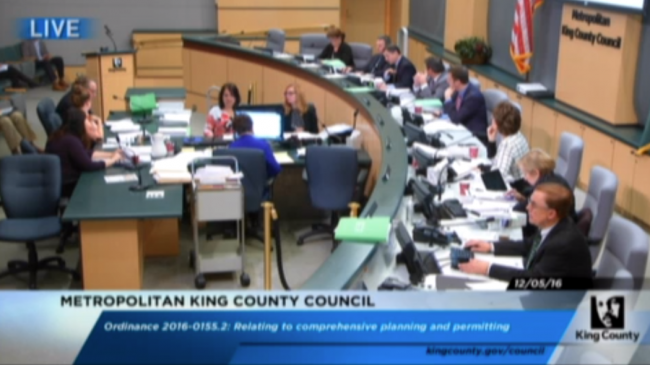The Metropolitan King County Council met last week to discuss and vote on the County’s Comprehensive Plan major update, a process that occurs once every four years. In a brief three weeks ago, we outlined a variety of land use and zoning changes proposed at the committee review level. The package of amendments proposed at that time were approved at committee hearing two weeks ago, but further changes were proposed at last week’s full County Council meeting. The proposed amendments to the approved Comprehensive Plan are summarized below, but of interest to most urbanists are land use changes. The Metropolitan King County Council voted on two primary amendments related to that topic, but by and large the approved Comprehensive Plan contracts King County’s Urban Growth Area–though there are minor changes related to very small notch expansions–and increases infill development capacity within pre-existing Urban Growth Areas.
Amendment 1: Omnibus Technical Amendments
Councilmember Rod Dembowski’s Amendment 1 was an omnibus amendment to address technical changes to the text of the proposed Comprehensive Plan related to agricultural lands and delay of the Skyway-West Hill area planning study. The amendment passed.
Amendment 2: Growth Targets
Councilmember Kathy Lambert had originally proposed to make a technical amendment to the growth targets appendix for the Urban Growth Area.
Key factors used in setting the UGA include population forecasts, growth targets, and land capacity. Population forecasts are predictions about future behavior based on past trends. Growth targets are a jurisdiction’s policy statement on ((
how many)) the minimum number of net new housing units it intends to accommodate in the future based on population forecasts and the expected size of the average household. Land capacity is derived from an estimate of vacant land plus the redevelopment potential of land already partially developed or underutilized. Discount factors are applied to the estimate of land capacity to account for probable constraints to actually developing the land.
Councilmember Lambert noted that local jurisdictions traditionally treated apportioned growth targets as a floor instead ceiling, but that recent changes to the region’s VISION 2040 plan has turned the head on that thinking. Growth targets are projections of population, housing, and jobs that are apportioned through a collaborative process by cities, counties, and the Puget Sound Regional Council, the steward of VISION 2040. Councilmember Lambert, however, expressed particular concern that some cities–like North Bend–have been forced to hold off growth for long periods of time and even turn away certain types of jobs to meet the goals of the regional vision. In her remarks, Councilmember Lambert said that her philosophy is to allow local jurisdictions decide where and how much growth they should take on with the understanding that growth targets aren’t an upper maximum.
Councilmember Lambert’s concerns arguably have recently manifested. Earlier this year, the PSRC put pressure on outlaying jurisdictions like Carnation and Covington to curb their proposed infill policies and development regulations, or risk decertification of their Comprehensive Plans. The threat of decertification could mean that those jurisdictions would be denied scarce federal transportation dollars that flow through the PSRC. But the intent of the growth policy for outer urban jurisdictions is to slow growth outside or near the edge of the central Urban Growth Area in King County to focus most of the growth in Metropolitan, Core, and Larger cities.
While Councilmember Lambert withdrew her proposed amendment, it would have had the effect of setting growth targets by the King County Growth Management Planning Council as a minimum as opposed to a maximum, in much the same way that Seattle is treating its updated Comprehensive Plan.
Amendment 3: Revising Development Code Language
Councilmember Dembowski proposed a technical amendment to revise the County’s development code so as to align language related to “Rural Area” and “Natural Resource Lands” that were incorporated in the new Comprehensive Plan by the TrEE Committee earlier in the legislative process; the amendment passed.
Amendment A-1: Omnibus Amendment
Councilmember Dembowski offered another omnibus amendment that focused on an updated executive summary statement, minor language revisions on topics of sustainable farming and land use subarea studies, wholesale policy changes surrounding the issues of gun violence and limiting lead exposure, delaying the subarea planning work for the Skyway-West Hill area until 2017, and adding a water study to the County work program in response to the recent Hirst Decision (Whatcom County v. Western Washington Growth Management Hearings Board) by the Washington State Supreme Court.
The latter addition to the work plan is particularly important from a land use perspective since the court case deals with permit-exempt wells in rural areas, adequacy of in-stream flows and water availability, and the inherent intersection of policy in development codes and Comprehensive Plan. The amendment set a timeline for an initial report on water policy for December 1, 2017, followed by a final report and transmittal of policy amendments to the Comprehensive Plan by July 1, 2018. The amendment passed as amended.
Amendment A-2: Water Availability
Building upon Amendment A-1’s water study, Councilmember Lambert offered an amendment that would require County planners, as part of the study, to “…analyze methods to accommodate current zoning given possible water availability issues and will look at innovative ways to accommodate future development in any areas with insufficient water by using mitigation measures (e.g. water banks).” The amendment passed.
Amendment A-3: Amendment to Attachment A
As noted above for Amendment 3, the purpose of that amendment was to bring consistency between select section of the County’s development code with the Comprehensive Plan. Amendment A-3 was the parallel Comprehensive Plan text amendment to revise language in the Comprehensive Plan to use the “Rural Area” and “Natural Resource Lands” terminology and topics. Sponsored by Councilmember Dembowski, the amendment passed.
Amendment A-4: Fully Contained Communities
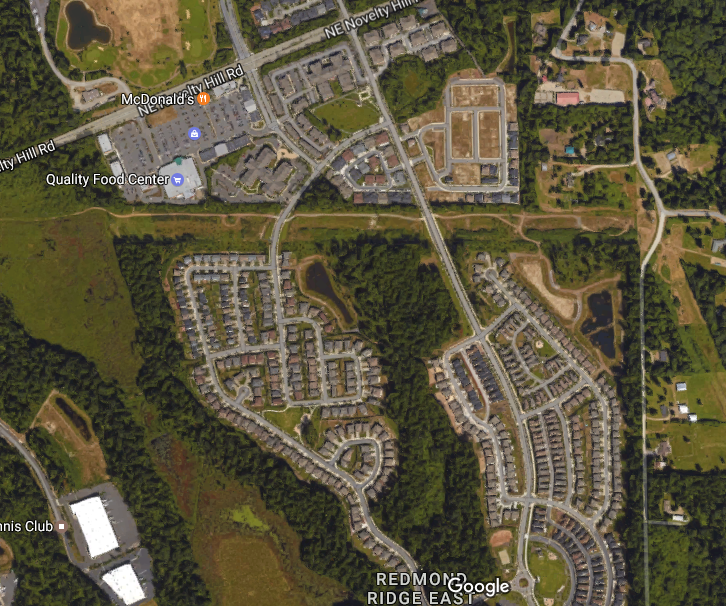
Councilmember Lambert had planned to offer an amendment to strike language related to full contained communities (i.e., Redmond Ridge and Redmond Ridge East) from the Comprehensive Plan, but made a motion to withdrawn it. Before doing so, however, Councilmember Lambert explained why she felt it was important to revisit the issue in future years:
We had an employ come up this morning and say “I love living in a masterplanned community that I just moved to.” I hear that often from people who live in fully contained communities. Fortunately, most of them are in my district and people love them, but we’ve decided that we are not going to build any in the future.
The language as it is written is pretty harsh right now and I was trying to get it softened because we don’t know in the future exactly what the future may bring. And if you read yesterday’s Seattle Times, which I’d like to talk about at the end, it’s pretty startling what could happen if an earthquake hit this area, and we may want to build some fully contained communities.
So I am sad that we have so abrupt–I think is the right word–on how we are going to deal with this type of housing construction in forming communities. It is a great way of having people be able to work and play and live in a close proximity.
The adopted language (Policy U-181) in the Comprehensive Plan states:
Except for existing Fully Contained Community designations, no new Fully Contained Communities shall be approved in King County.
Amendment A-5: Rural Area Policy On Business Activities
Councilmember Lambert proposed three-word change to a Comprehensive Plan policy in the Rural Areas and Natural Resources Element. The amendment centered on the phrase “for nearby residents” (see below) which is an acknowledgement that non-residential uses that provide local products and services should not be scaled for larger markets (e.g., Costco, Walmart, or even Safeway).
Nonresidential uses in the Rural Area shall be limited to those that:
a. Provide convenient local products and services ((
for nearby residents));b. Require location in a Rural Area;
c. Support natural resource-based industries;
d. Provide adaptive reuse of significant historic resources; or
e. Provide recreational and tourism opportunities that are compatible with the surrounding Rural Area.
Councilmember Lambert expressed concern that the policy was unenforceable and unfair to rural residents and business owners.
Planning staff were called upon by Councilmembers to clarify application of the policy. Staff noted that the specific text constituted policy contained within the Comprehensive Plan–policy that has existed within the Comprehensive Plan since 2004–but had been proposed for further “tightening” earlier in the legislative process. As a policy, the language essentially serves as a box that subsequent development regulations (codified land use ordinances) must be formed within by decision-makers. Staff did note, however, that there are instances of land use permitting that decision-makers (e.g., administrative review staff, Hearing Examiner, or County Council) may rely upon the policy–through say conditions for a Conditional Use Permit or SEPA–but that the policy would only be considered in the larger context of decision criteria, development regulations, and other relevant policies.
The amendment failed on vote of the Metropolitan King County Council.
Amendment A-6: Watershed Planning
King County is in the process of working through a watershed planning effort specific to the Snohomish Valley Agriculture Production District. The process was included as a policy in the Comprehensive Plan detailing the intent to implement related recommendations that derived from the Snoqualmie Fish, Farm, and Flood Advisory Committee. The policy sets an expectation that the committee will continue to monitor the progress of task forces and evaluate County’s watershed planning approach for the agricultural region, and that permanent policies will be recommended for the next major update to the County’s Comprehensive Plan. Councilmember Lambert offered an amendment to clarify that the planning approach and recommendations for the Snohomish Valley is unique and should not “broadly applied in other Agricultural Production Districts.” The amendment passed.
Amendment A-7: Public Spending
King County has a policy (Policy F-208) that speaks to how the County prioritizes public spending to facility local needs. The original version of the policy spoke only to investments related to growth and coordination through Capital Facility Plans (CFPs). CFPs are mandated to be updated annually by the Growth Management Act to ensure that the delivery of public services are adequately aligned with goals and objectives of the Comprehensive Plan. Councilmember Lambert offered an amendment to indicate the County’s intention to maintain existing services outside of the Urban Growth Area–an obligation that the County has:
Public spending to support growth should be directed to the Urban Growth Area and to maintain existing unincorporated infrastructure, and should be prioritized ((
and coordinated)) through the Capital Facility Plan((s)) to comply with the concurrency requirements of the Growth Management Act.
There was some concern amongst councilmembers over a change to the text and the implications that it might have, but the amendment ultimately passed.
Amendment A-8: Unincorporated Area Services
King County has a policy (Policy F-209a) that outlines some of the local services that the County will provide for unincorporated areas. These include: permitting, courts, land use controls, law enforcement, parks, transportation, natural resources management assistance, and surface water management. Councilmember Lambert wanted to add one item to the list, that being “economic development.” The amendment passed.
Amendment B-1.A and B-1.E: Amendment to Fairwood A
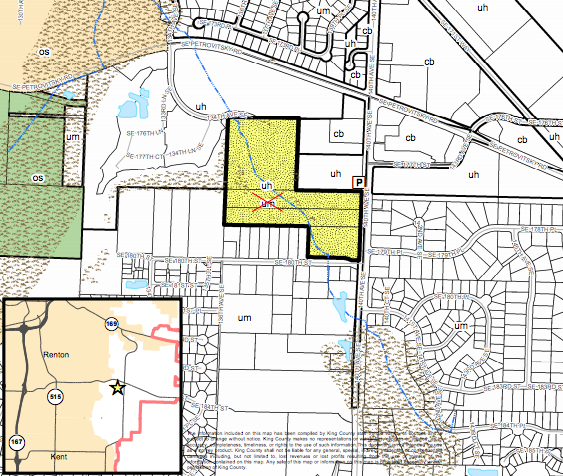
For a little background, a series of four parcels were proposed to received Future Land Use Map and zoning map amendments. The King County Executive’s Recommended Plan earlier this year only proposed to increase residential densities on the northern most parcel from Urban Residential Medium (um) to Urban Residential High (uh) with a corresponding rezone from R-6 to R-18. Meanwhile, the southern three parcels were proposed to remain unchanged.
The Metropolitan King County Council’s land use planning committee proposed an amendment to the redesignate and rezone the southern three parcels of land as well, subject to specific conditions and denoted on the proposed zoning map with a special “P” suffix. The conditioned zoning would required any future multi-family residential project to include some combination of senior residential single-family, senior citizen assisted housing, day care facilities, and nursing and personal care facilities, or if none of those, the project would have to provide at least 20% of the new residential units as affordable for moderate-income households.That amendment was approved at the committee level.
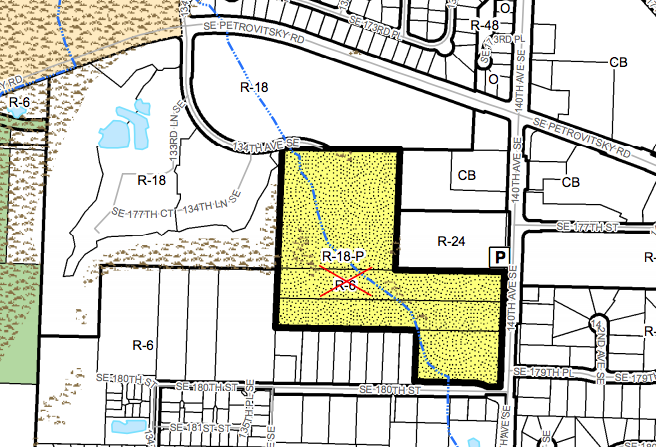
However, Councilmember Reagan Dunn, who represents the area in Fairwood, sought to offer an amendment (B-1.A) that would have:
- Removed the the uh land use designation to keep the parcels as um;
- Removed the R-18 zoning to the parcels as R-6; and
- Removed the specific conditions set on the properties.
Councilmember Dunn cited wide ranging concerns of residents in the area, such as lighting, crime, building heights, environmental impacts, and traffic congestion resulting from higher density development, despite development likely taking the form of senior housing. Councilmember Dave Upthegrove spoken in response to Councilmember Dunn’s comments saying:
If we aren’t able to accommodate growth within the Urban Growth Boundary, then we’re going to continue to have problems with housing affordability. Growth is coming whether we like it or not, just look at the statistics and growth in this region. The PSRC says that we will experience 25% growth in the next 25 years. This neighborhood and neighborhoods like it will be seeing increased…population density. That’s why we have an urban growth area. There’s things inside and outside. Change is difficult, I understand that….If I were going to have growth in my community, I would probably prefer it to have this level…[of] senior [housing desnity] which has lower…traffic patterns. I’d like to see a proposal like this one that has a significant set-aside–60% of the land preserved as greenbelt open space, 20% of the units affordable. And so I think if we get to the point that we’re not able to accommodate increased density within our urban growth areas…that we’d have a real problem with having pressure on the urban growth boundary and rural areas.
The vote on amendment B-1.A failed.
Councilmember Dembowski then offered a friendly amendment (B-1.E) to address some of the concerns that Councilmember Dunn raised. Packaged into the amendment were additional conditions:
- Requirements for a conservation easement along the western edge of the four properties;
- Establishment of a maximum building height of 65 feet on the northern three parcels;
- Limitations on permitted land uses for the northern three parcels to only single-family residences for seniors, senior citizen assisted living housing, senior day care facilities, and nursing and personal care facilities;
- Establishment a sunset clause for December 31, 2023 for the Council-approved land use designation and zoning contingent upon submission of a development application; and
- Requirements for a Conditional Use Permit public process that has light design review elements to evaluate issues like building design, lighting, parking and traffic impacts, and setbacks
The conservation easement would have to be recorded against the properties prior to development permits being applied for and would need to encumber all critical areas and a buffer area west of them to provide separation from lower-density residential areas adjacent to the site. The friendly amendment passed allowing the land use designation and rezone changes to occur on the properties.
Amendment B-2: Reserve at Covington Creek
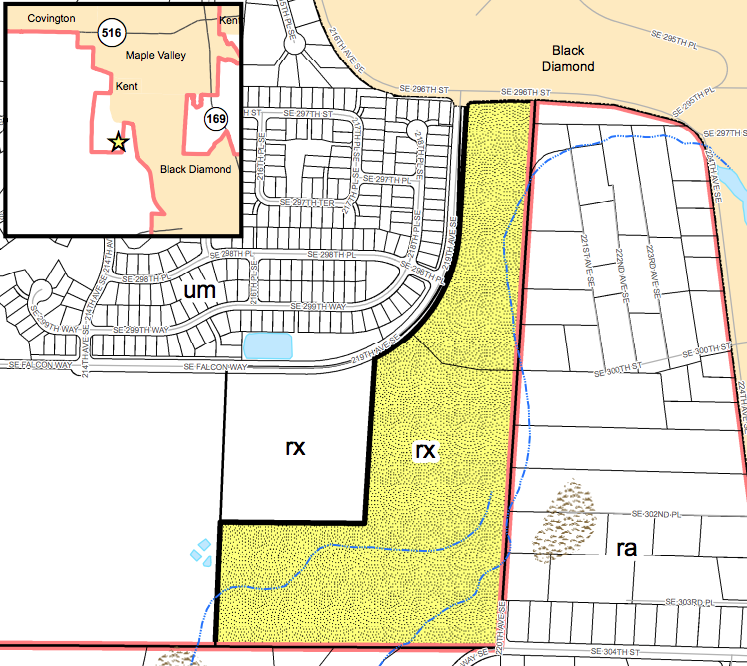
A final land use amendment was offered by Councilmember Dembowski to amend zoning conditions attached to a Four-to-One development near Kentlake High School in the Black Diamond. The amendment proposed to:
- Eliminate a pre-annexation agreement requirement with Black Diamond and instead condition future properties with a no-contest covenant for annexation;
- Revise allowed densities on the property so that a maximum of 80 dwelling units is permitted and that the average density not exceed four units per acre on 50% of the site;
- Add language that requires 160.53 acres be put into conservation status through various means (e.g., on-site conservation easements, purchase of Transfer of Development Rights, and conservation of high priority sites elsewhere in King County);
- Eliminate a condition requiring consistency with Black Diamond development regulations; and
- Revise language related to transportation concurrency.
The amendment passed.
Decision
Ultimately, the Metropolitan King County Council approved the amendment Comprehensive Plan ordinance, paving the way for the new ordinance to become effective once King County Executive Dow Constantine signs off. The next major update to the County’s Comprehensive Plan will occur in 2020 with minor annual amendments in the intervening years.
Attachment A – King County Comprehensive Plan – 12-05-16 by The Urbanist on Scribd
Stephen is a professional urban planner in Puget Sound with a passion for sustainable, livable, and diverse cities. He is especially interested in how policies, regulations, and programs can promote positive outcomes for communities. With stints in great cities like Bellingham and Cork, Stephen currently lives in Seattle. He primarily covers land use and transportation issues and has been with The Urbanist since 2014.

